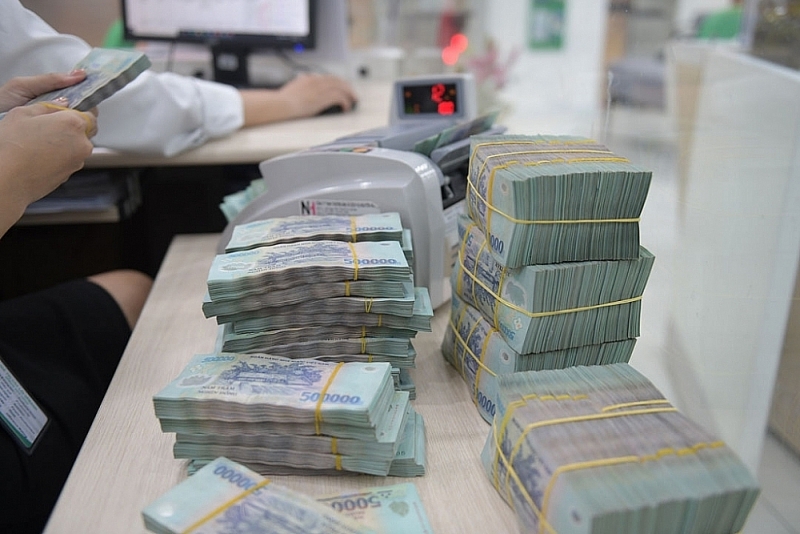VCN – From the beginning of May until now, many banks have further reduced deposit interest rates for all terms, but lending rates have remained relatively high.
The beginning of the wave of interest rate cuts in May was from the leading banks
Accordingly, at a 3-month term, interest rates at Vietcombank, VietinBank, BIDV are now only 5.1%/year, 0.3%/year lower than the first week of May. Interest rate for 6-9 month term fell down 0.3-0.4%/year to 5.8%/year, 12-month term interest rate decreased by 0.2% to 7.2%/year.
With the group of private joint stock commercial banks, the abundant liquidity also helped these banks reduce deposit interest rates.
For example, from the 2nd week of May, Techcombank further reduced the deposit interest rate by 0.2% for terms of 6 months or more. VPBank, and TPBank also reduced interest rates by 0.15-0.2% for some terms.
As a result, the highest savings interest rate at commercial banks ranges from 7.5-8%/year for mid-range banks from 8.5-8.8 %/year for small banks.
According to the State Bank of Vietnam (SBV), deposit interest rates have continuously decreased since the beginning of February, especially after the State Bank reduced the operating interest rate twice in mid-March and early April.
Compared to the peak period at the beginning of the year, the deposit interest rates listed at banks have decreased by 0.5-1.7% in all terms. Thus, the deposit interest rate decreased by nearly 3% per year compared to the end of 2022.
In a recent analysis report, VnDirect Securities Company expects the average 12-month deposit interest rate to fall to 7% in 2023. The SBV may further reduce the operating interest rate if the US Federal Reserve (Fed) reverses monetary policy in the second half of 2023.
 |
| Loan interest rates have not decreased much, making it difficult for businesses. Photo: ST |
Although deposit interest rates have tended to decrease since the beginning of the year until now, according to the latest data released by the State Bank of Vietnam, by the end of February, total customer deposits at the credit institution system reached more than VND 11,795 quadrillion, equivalent to a decrease of about 0.27% compared to the end of 2022. Thus, in the first 2 months of the year, a total of about VND 23,780 billion of customer deposits were withdrawn from the bank.
The reason for the above decline came from the sharp decrease in deposits of economic organizations. It is estimated that after only the first 2 months of the year, deposits of economic organizations have decreased by VND 338 trillion. Meanwhile, deposits from residents after the first two months of the year increased by VND 314,000 billion (equivalent to an increase of 5.36%), marking 15 consecutive months of positive growth.
According to a report from the Institute for Economic and Policy Research (VEPR), capital mobilization in the economic organization sector decreased while credit growth was slow, reflecting the problematic liquidity situation of enterprises; good businesses with excess liquidity had to withdraw their deposits to meet their own liquidity needs.
The lack of liquidity of enterprises also comes from the reason that lending interest rates have remained the same as expected although deposit rates have dropped sharply. Actual statistics of SSI Securities Company show that the lending interest rate is still at a higher level than before Covid-19, ranging from 10-10.5%/year for a 6-month term and 11-12%/year for a 12-month term for ordinary manufacturing enterprises while consumer loan or home loan interest rates remain relatively high around 13.5-14%/year.
A representative of the State Bank explained that to reduce lending interest rates in the market, there must be a delay because each credit institution previously had to mobilize at high interest rates as well as the extent of the reduction depended on financial capacity of each bank.
In the recent report of the State Bank to the National Assembly Economic Committee, the Governor of the State Bank of Vietnam said that the reduction of lending interest rates under the direction of the National Assembly faces many difficulties and challenges as major central banks continue the process of tightening monetary policy, raising interest rates and keeping them at a high level; Inflation pressures at home and abroad are at a high level along with an increase in interest rates in 2022.
 | Loosening credit room – giving priority to banks with high liquidity and lower interest rates |
Therefore, the monetary authority has said many times that it will continue to direct credit institutions to make efforts to minimize costs, creating conditions to reduce lending interest rates to the economy.
By Huong Diu/Bui Diep
